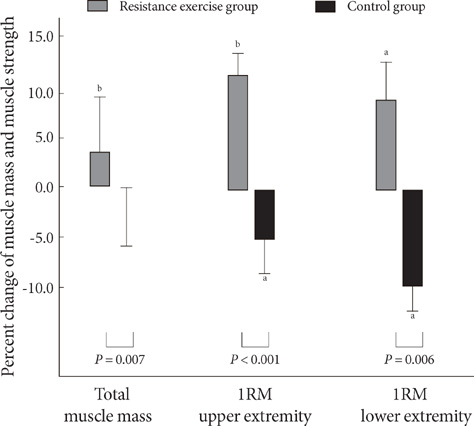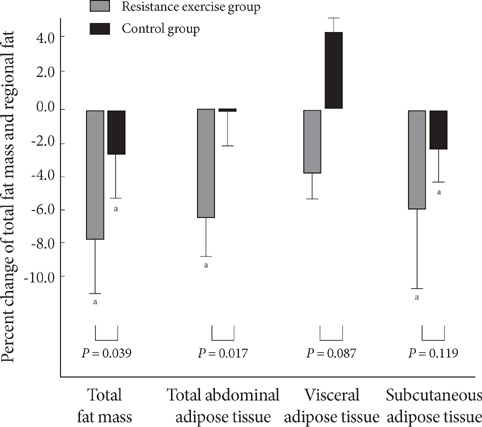Korean Diabetes J.
2010 Apr;34(2):101-110. 10.4093/kdj.2010.34.2.101.
The Effects of Resistance Training on Muscle and Body Fat Mass and Muscle Strength in Type 2 Diabetic Women
- Affiliations
-
- 1Diabetes Center, Eulji Hospital, Seoul, Korea.
- 2Department of Internal Medicine, Eulji University School of Medicine, Daejeon, Korea. minyungwa@yahoo.co.kr
- 3Department of Internal Medicine, Seoul National University College of Medicine, Seoul, Korea.
- 4Kim Ho Chul Radiology Clinic, Seoul, Korea.
- KMID: 2222384
- DOI: http://doi.org/10.4093/kdj.2010.34.2.101
Abstract
- BACKGROUND
Our goal was to investigate the effects of low intensity resistance training on body fat, muscle mass and strength, cardiovascular fitness, and insulin sensitivity in type 2 diabetes.
METHODS
Twenty-eight overweight women with type 2 diabetes were randomly assigned to a resistance training group (RG, n = 13) or a control group (CG, n = 15). RG performed resistance training using elastic bands, of which strength was equal to 40 to 50% of one repetition maximum (1RM), for three days per week. Each exercise consisted of three sets for 60 minutes. We assessed abdominal fat using computed tomography, muscle mass using dual-energy X-ray absorptiometry, and muscle strength using Keiser's chest and leg press. Insulin sensitivity was measured using the insulin tolerance test, and aerobic capacity was expressed as oxygen uptake at the anaerobic threshold (AT-VO2) before and after the 12-week exercise program.
RESULTS
The age of participants was 56.4 +/- 7.1 years, duration of diabetes was 5.9 +/- 5.5 years, and BMI was 27.4 +/- 2.5 kg/m2, without significant differences between two groups. During intervention, a greater increase in muscle mass and greater decreases in both total fat mass and abdominal fat were observed in RG compared to those of CG (P = 0.015, P = 0.011, P = 0.010, respectively). Increase in 1RM of upper and lower extremities was observed in the RG (P = 0.004, P = 0.040, respectively), without changes in AT-VO2 and insulin resistance in either group.
CONCLUSION
In conclusion, the low intensity resistance training was effective in increasing muscle mass and strength and reducing total fat mass without change of insulin sensitivity in type 2 diabetic patients.
MeSH Terms
Figure
Cited by 2 articles
-
Effectiveness of Exercise Intervention in Reducing Body Weight and Glycosylated Hemoglobin Levels in Patients with Type 2 Diabetes Mellitus in Korea: A Systematic Review and Meta-Analysis
Ji-Eun Jang, Yongin Cho, Byung Wan Lee, Ein-Soon Shin, Sun Hee Lee
Diabetes Metab J. 2019;43(3):302-318. doi: 10.4093/dmj.2018.0062.The Effects of Aerobic/Resistance Exercise on Body Fat Mass, Muscle Strength and Endothelial Function in Korean Type 2 Diabetes mellitus Patients
Kyung Wan Min
J Korean Diabetes. 2011;12(1):6-12. doi: 10.4093/jkd.2011.12.1.6.
Reference
-
1. Baron AD, Brechtel G. Insulin differentially regulates systemic and skeletal muscle vascular resistance. Am J Physiol. 1993. 265:E61–E67.2. Ryan AS, Hurlbut DE, Lott ME, Ivey FM, Fleg J, Hurley BF, Goldberg AP. Insulin action after resistive training in insulin resistant older men and women. J Am Geriatr Soc. 2001. 49:247–253.3. Misra A, Alappan NK, Vikram NK, Goel K, Gupta N, Mittal K, Bhatt S, Luthra K. Effect of supervised progressive resistance-exercise training protocol on insulin sensitivity, glycemia, lipids, and body composition in Asian Indians with type 2 diabetes. Diabetes Care. 2008. 31:1282–1287.4. Sigal RJ, Kenny GP, Boule NG, Wells GA, Prud'homme D, Fortier M, Reid RD, Tulloch H, Coyle D, Phillips P, Jennings A, Jaffey J. Effects of aerobic training, resistance training, or both on glycemic control in type 2 diabetes: a randomized trial. Ann Intern Med. 2007. 147:357–369.5. Ibanez J, Izquierdo M, Arguelles I, Forga L, Larrion JL, Garcia-Unciti M, Idoate F, Gorostiaga EM. Twice-weekly progressive resistance training decreases abdominal fat and improves insulin sensitivity in older men with type 2 diabetes. Diabetes Care. 2005. 28:662–667.6. Cha BS, Won YJ, Lee JH, Nam SY, Song YD, Lee EJ, Lim SK, Kim KR, Lee HC, Huh KB, Shin MJ, Lee JH. The correlation between insulin resistance and the visceral fat vs skeletal muscle ratio in middle-aged women. J Korean Diabetes Assoc. 1996. 20:395–409.7. Mourier A, Gautier JF, De Kerviler E, Bigard AX, Villette JM, Garnier JP, Duvallet A, Guezennec CY, Cathelineau G. Mobilization of visceral adipose tissue related to the improvement in insulin sensitivity in response to physical training in NIDDM: effects of branched-chain amino acid supplements. Diabetes Care. 1997. 20:385–391.8. An KH. Effect of low intensity aerobic exercise in type 2 diabetic patients. J Korea Sport Res. 2005. 16:421–429.9. Kwon HR, Ku YH, Ahn HJ, Jeong JY, Ryu SR, Koo BK, Han KA, Min KW. Maximal muscle strength deteriorates with age in subjects with type 2 diabetes mellitus. Korean Diabetes J. 2009. 33:412–420.10. Kwon HR, Han KA, Ku YH, Ahn HJ, Koo BK, Min KW. Relationship of maximal muscle strength with body mass index and aerobics capacity in type 2 diabetic patients. Korean Diabetes J. 2009. 33:511–517.11. Sigal RJ, Kenny GP, Wasserman DH, Castaneda-Sceppa C. Physical activity/exercise and type 2 diabetes. Diabetes Care. 2004. 27:2518–2539.12. Dunstan DW, Daly RM, Owen N, Jolley D, De Courten M, Shaw J, Zimmet P. High-intensity resistance training improves glycemic control in older patients with type 2 diabetes. Diabetes Care. 2002. 25:1729–1736.13. Castaneda C, Layne JE, Munoz-Orians L, Gordon PL, Walsmith J, Foldvari M, Roubenoff R, Tucker KL, Nelson ME. A randomized controlled trial of resistance exercise training to improve glycemic control in older adults with type 2 diabetes. Diabetes Care. 2002. 25:2335–2341.14. Patterson RM, Stegink Jansen CW, Hogan HA, Nassif MD. Material properties of Thera-Band Tubing. Phys Ther. 2001. 81:1437–1445.15. Hughes CJ, Hurd K, Jones A, Sprigle S. Resistance properties of Thera-Band tubing during shoulder abduction exercise. J Orthop Sports Phys Ther. 1999. 29:413–420.16. An KH, Min KW, Han KA. The effects of aerobic training versus resistance training in non-obese type 2 diabetics. J Korean Diabetes Assoc. 2005. 29:486–494.17. Bonora E, Moghetti P, Zancanaro C, Cigolini M, Querena M, Cacciatori V, Corgnati A, Muggeo M. Estimates of in vivo insulin action in man: comparison of insulin tolerance tests with euglycemic and hyperglycemic glucose clamp studies. J Clin Endocrinol Metab. 1989. 68:374–378.18. Dean CM, Richards CL, Malouin F. Task-related circuit training improves performance of locomotor tasks in chronic stroke: a randomized, controlled pilot trial. Arch Phys Med Rehabil. 2000. 81:409–417.19. Borkan GA, Gerzof SG, Robbins AH, Hults DE, Silbert CK, Silbert JE. Assessment of abdominal fat content by computed tomography. Am J Clin Nutr. 1982. 36:172–177.20. Baechle TR, Earle RW. Essentials of strength training and conditioning. 2000. 2nd ed. Champaign: Human Kinetics.21. Majima M, Kondoh T, Eguchi KF, Fujii H, Komiyama G, Suzuki E, Sowa K. Effect of endurance exercise at intensity corresponding to anaerobic threshold on improvement of cardiorespiratory fitness in stroke patients aged below 59 and over 60 years. Jpn J Rehabil Med. 1998. 35:485–490.22. American College of Sports Medicine. ACSM's guidelines for exercise testing and prescription. 2006. 7th ed. New York: Lippincott Williams and Wilkins.23. Fleck SJ, Kraemer WJ. Designing resistance training programs. 1997. 2nd ed. Champaign: Human Kinetics.24. Iannuzzi-Sucich M, Prestwood KM, Kenny AM. Prevalence of sarcopenia and predictors of skeletal muscle mass in healthy, older men and women. J Gerontol A Biol Sci Med Sci. 2002. 57:M772–M777.25. Jung DJ, Joo KC. The effects of resistance exercise by elastic band for improved to daily living physical fitness in old-age women. Exerc Sci. 2003. 12:253–265.26. Kim KB. The effect of elastic band training on serum leptin level and health-related physical fitness in obese women with diabetes. J Korea Sport Res. 2004. 15:713–724.27. Cuppini A, Matteini P. Obesity and metabolic syndrome: clinical and therapeutic review. Monaldi Arch Chest Dis. 2005. 64:45–49.28. Mori Y, Hoshino K, Yokota K, Yokose T, Tajima N. Increased visceral fat and impaired glucose tolerance predict the increased risk of metabolic syndrome in Japanese middle-aged men. Exp Clin Endocrinol Diabetes. 2005. 113:334–339.29. Kwon YC, Park JH, Yun MS, Park SK. The effects of muscular resistance training on abdominal fat and insulin concentration in obese middle-aged women. J Sport Leis Stud. 2002. 17:127–136.30. Lee KS, Kim MH. The analysis of relationships on plasma leptin and insulin, glucose levels and body composition in obese women with NIDDM during band training. Exerc Sci. 2002. 11:131–143.31. Han TR. Exercise in the elderly. J Korean Acad Rehabil Med. 2002. 26:121–126.32. So WY, Jun TW, Seo DI, Chang H, Seo HK, Eom WS, Park ST, Park JY, Lee HJ, Park SK, Kim JH, Song W. Effects of 12 weeks elastic band exercise on body composition, cardiorespiratory function and physical fitness of middle-aged obese women. Korean J Obes. 2008. 17:132–140.33. Holten MK, Zacho M, Gaster M, Juel C, Wojtaszewski JF, Dela F. Strength training increases insulin-mediated glucose uptake, GLUT4 content, and insulin signaling in skeletal muscle in patients with type 2 diabetes. Diabetes. 2004. 53:294–305.34. Dela F, Kjaer M. Resistance training, insulin sensitivity and muscle function in the elderly. Essays Biochem. 2006. 42:75–88.35. Cheng YJ, Gregg EW, De Rekeneire N, Williams DE, Imperatore G, Caspersen CJ, Kahn HS. Muscle-strengthening activity and its association with insulin sensitivity. Diabetes Care. 2007. 30:2264–2270.36. Gordon BA, Benson AC, Bird SR, Fraser SF. Resistance training improves metabolic health in type 2 diabetes: a systematic review. Diabetes Res Clin Pract. 2009. 83:157–175.37. Brooks N, Layne JE, Gordon PL, Roubenoff R, Nelson ME, Castaneda-Sceppa C. Strength training improves muscle quality and insulin sensitivity in Hispanic older adults with type 2 diabetes. Int J Med Sci. 2007. 4:19–27.38. Gordon PL, Vannier E, Hamada K, Layne J, Hurley BF, Roubenoff R, Castaneda-Sceppa C. Resistance training alters cytokine gene expression in skeletal muscle of adults with type 2 diabetes. Int J Immunopathol Pharmacol. 2006. 19:739–749.39. Colberg SR, Parson HK, Nunnold T, Herriott MT, Vinik AI. Effect of an 8-week resistance training program on cutaneous perfusion in type 2 diabetes. Microvasc Res. 2006. 71:121–127.40. Baldi JC, Snowling N. Resistance training improves glycaemic control in obese type 2 diabetic men. Int J Sports Med. 2003. 24:419–423.
- Full Text Links
- Actions
-
Cited
- CITED
-
- Close
- Share
- Similar articles
-
- The Effects of Aerobic/Resistance Exercise on Body Fat Mass, Muscle Strength and Endothelial Function in Korean Type 2 Diabetes mellitus Patients
- Relationship of Maximal Muscle Strength with Body Mass Index and Aerobics Capacity in Type 2 Diabetic Patients
- Resistance Exercise Strategies for Sarcopenic Obesity in Elderly People
- Maximal Muscle Strength Deteriorates with Age in Subjects with Type 2 Diabetes Mellitus
- The Effect of Sprint and Heavy Resistance Training on Muscle Strength, Endurance and Muscle Fiber Type



